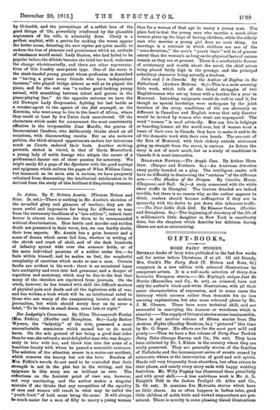GIFT-BOOKS.
MORE FAIRY STORIES.
Suvue.u. books of fairy tales published in the last few weeks call for notice before Christmas, if at all. Of old friends, Mrs. Craik's The Fairy Book (T. Nelson and Sons, 65:) reappears in a new edition with coloured illustrations by competent artists. It is a well-made selection of thirty-five favourite European stories.—Mr. Kipling's unique Just So Stories (Macmillan and Co., 6s. net), as reissued, have not only the author's black-and-white illustrations, with all their queer characteristics of expression, and in some cases the intricacy which excuses rather than demands his no less amusing explanations, but also some coloured plates by Mr. J. M. Gleeson. These have more technical skill, and are successful in conveying the humour or weirdness which is aimed at.—The supply of Oriental stories seems inexhaustible. There is yet another volume of fifteen stories from The Arabian Nights (Headley Brothers, 5s.), "pictured" this time by Mr. G. Soper. His efforts are for the most part mild and pretty.—Then we have a fine volume of Forty-Four Turkish Fairy Tales (George Harrap and Co., 10s. net). They have been collected by Dr. I. Kenos in the country where they are orally preserved. They are generally stories of the families of Padishahs and the inconsequent series of events caused by autocratic whims or the intervention of good and evil spirits. Heads roll very frequently from shoulders, but often return to their places, and nearly every story ends with happy wedding festivities. Mr. Willy Pogg.ny has illustrated them plentifully and with great skilL—A less ambitions work is Mr. A. L. Knight's Told in the Indian Twilight (G. Allen and Co., 2s. 6d. net). It contains Eve Mahratta stories which have no little charm. As so often happens in Indian tales, good little children of noble birth and wicked stepmothers are pro- minent. There is novelty in some pleasing tinted illustrations
by an Indian artist, which render the intrusion of a private photograph as frontispiece the more inexcusable.—There are two hooks which show that the power to write fairy stories round modern children is not quite extinct. One is Jack and Jill, by Dr. Greville Macdonald (J. M. Dent and Sons, ;is. net). There is just a tinge of the didactic here and there, and the story is a trifle long, but it is a good successor to the author's last story of Sussex children spirited away into fairy- land. The boy and a delightful dog have a terrific fight with a very evil dragon. It is carefully illustrated by Mr. Arthur Hughes, who has quite caught the spirit of the tale. The other book is Wet Magic (T. Werner Laurie, 6s.), by that practised writer for children, E. Nesbit. Here some children are most vividly introduced by a mermaid to life under the sea, and plunged into the Mer-folk's last war.—There are two other books which take the risk of combining instruction with amusement. One is Pinocchio Under the Sea (Macmillan and Co., 6s.), a small volume in which Rembadi's amusing marionette travels with some didactic dolphins who give him instruction in morale as well as in many fishy subjects. It is translated by C. M. Della Chiesa and illustrated by Miss Wilde. The second volume, In the Once upon a Time (George Harrap and Co., 3s. 6d. net), is called "a fairy-tale of science," but does not deal with magic. Miss Lilian Gask puts a boy in the companionship of a learned professor, who makes his holidays a joy by taking him to museums and expounding the origin of species and much prehistoric anthropology.— Lastly there is a volume of supernatural narrative which is of great interest, though not a children's book. It is a hand- some volume containing translations of von Chamisso's and Wilhelm Hauff's stories, called in English The Shadowless Man and The Cold Heart (Holden and Hardingham, 15s. net). They have introductions by Dr. Rappoport and Mr. Robertson Murray, and pictures by Mr. Forster Robson, which convey some of the whimsicalness of the stories as well as the unhappy mystery which characterises at any rate the first story. Each is worth having in English.











































 Previous page
Previous page